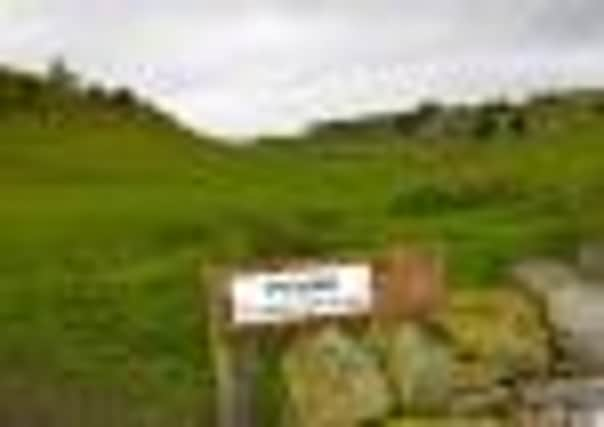Following a walkers’ bible into a dispute


The celebrated author of walking guides, Alfred Wainwright, had an eye for a beautiful landscape.
He often described his passion for the Lake District fells while his love of the Yorkshire Dales inspired some of his most emotional and poetic writing.
Advertisement
Hide AdAdvertisement
Hide AdOne area of the Dales that appealed to Wainwright was Happy Valley, a delightful miniature dale which runs in an elevated north-west to south-east direction near Settle.
“The Happy Valley,” he wrote in his Walks in Limestone Country, “is a local name for a truly peaceful upland hollow vacated by a glacier ages go, now a lush pasture inurned by limestone cliffs where cows and sheep graze in contentment, and the name is very appropriate.
“The valley has an echo, but visitors will be loath to disturb the stillness and serenity of this delightful place by provoking it. Walk slowly through the Happy Valley and feel its calm.”
It is more than 40 years since Wainwright wrote those words, but signs have now appeared at the entrance to the Happy Valley stating that it is private ground and there is no right of access.
Advertisement
Hide AdAdvertisement
Hide AdLast month I contributed a walk to Country Week which included the one-kilometre footpath through the valley.
The farmer who owns the land, John Dugdale, of Borrins, Stackhouse, near Settle, then contacted the Yorkshire Post.
He demanded a retraction of the walk and a clear statement that it was not a public right of way.
Mr Dugdale is correct on this point.
The “definitive map” on which the Ordnance Survey bases its maps for walkers shows that while a path is clearly indicated through the valley, it is not classified as “a public right of way”.
Advertisement
Hide AdAdvertisement
Hide AdThis is a walk I first enjoyed in 1977, and it is one I have done at least three times since then.
On no occasion was there anything on the ground to suggest that walkers are discouraged from using this path.
On my most recent visit I met other walkers in the Happy Valley, as I had on previous occasions.
There’s a wall stile at the southern end of the valley and the remains of a waymarking stile.
Advertisement
Hide AdAdvertisement
Hide AdStiles and waymark signs are the normal infrastructure associated with footpaths, and they would not be there if there was no tradition of walking along this route.
It is not surprising that it has been well used.
Wainwright’s Walks in Limestone Country was published in 1970 and the tradition of walking through the Happy Valley predates Wainwright’s book.
He mentioned that the valley’s name – which does not appear on OS maps – was given by local people.
The book’s publishers, Frances Lincoln, have no record of any complaints being made regarding the route.
Advertisement
Hide AdAdvertisement
Hide AdMr Dugdale says he had never asked for the route to be amended or removed from Walks in Limestone Country.
He says he accepted that many walkers use the Happy Valley route and adds, “We don’t challenge 90 per cent of people because a lot of people are very honest, straight people and they enjoy the walk for what it is.”
Mr Dugdale’s main concern, he says, was that there was the potential to be Friesian bulls in the valley, and that could be “lethal”.
Peter Linney, secretary of the Wainwright Society, says he has used the Happy Valley footpath at least twice, the most recent visit with three of his grandchildren.
Advertisement
Hide AdAdvertisement
Hide Ad“It’s a delightful little walk,” he says. “I think the Wainwright Society would take the view that it’s a poor show when it comes to the point of having no access at all, and we’d hope the farmer would make some accommodation for walkers.
“It’s not as if there’s ever going to the thousands of people walking that route.”
Colin Speakman, chairman of the Yorkshire Dales Society, who has also walked through the Happy Valley, said that the most sensible way would be for the farmer to voluntarily agree to a permissive footpath.
If not, there are two possible courses of action to keep the valley open to walkers.
Advertisement
Hide AdAdvertisement
Hide AdOne is for the Yorkshire Dales National Park to consider a formal application for the path to be put on the definitive map and made a public right of way.
This has a chance of succeeding if it can be proved that walkers have been using a path for at least 20 years which seems to be the case in the Happy Valley.
A second course would be for the Happy Valley to be included in the Open Access area when it is next reviewed by Natural England.
A Yorkshire Dales National Park area warden is to meet Mr Dugdale to discuss the possibility of a “permissive path”. This would allow walkers access to the Happy Valley once again without it being an official public right of way.
Wainwright and Happy Valley
Advertisement
Hide AdAdvertisement
Hide AdFirst published in 1970, Wainwright’s Walks in Limestone Country, which was re-printed with an unaltered Happy Valley route in 2003, is probably the biggest selling walking guide to the Yorkshire Dales.
In 1991, Wainwright once again indicated that there was a route here, in his coffee table book titled Wainwright In The Limestone Dales.
If an agreement cannot be reached, the National Park, at the instigation of ramblers, will consider a formal application for the route be placed on the definitive map as a public footpath.